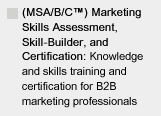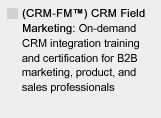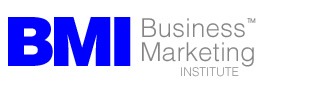MAKE SURE YOU CONTINUE TO RECEIVE EACH ISSUE OF TUESDAY MARKETING NOTES—CLICK HERE TO RENEW YOUR FREE SUBSCRIPTION
The Next New Big Thing (Part 2)
By Rick Kean, CBC
Last week we posed the question of whether we, as marketers, were actually witnessing a whole new way of doing business or whether we were just beginning to understand a new marketing tactic. So we began by putting down on paper some of the things we were confident of.
Here are a few more of those things . . .
7. A BUDGET IS NOT A PLAN
One of the most common marketing-related questions companies struggle with is “how much should we spend?” This is understandable. With as many budget schemes as there are Mozart arias to choose from, it can be difficult to decide on the right plan. But the single most important thing to remember is that a budget is not a plan.
How the money is allocated is determined by the program, it does not determine the program. That simple notion is often forgotten because the company always needs a budget before it needs the plan. So the budget gets done and the plan languishes. Before ever putting pencil to paper, there are three basic questions to ask: Where are we, where do we want to go, and what are we going to have to do to get there? Sound marketing decisions are simple when they come from informed planners. So being prepared at budget time means developing a marketing plan with a budget attached, not a budget with the justification attached.
And the question is not “how much is enough” to get the job done. The question is really “how much isn’t enough.” Budgets should not be justified by using historical information like a percentage of last year’s sales, or crystal ball gazing with this year’s foretasted sales. Or by those numbers that someone pulls out of a hat, that have little relationship with the company’s objectives, or trying to gauge what competitors spend. Marketing is an exercise in reality. Plans and budgets have to be built from the ground up. This means deciding what activities will be necessary to achieve specific marketing objectives to reach your target markets, and what resources will be necessary.
Keep in mind that a plan to maintain the comfortable status quo will be a target for efficiency demands. The experience curve is gospel to financial people. If you’ve done it before, they think you can do it again, for less money. A plan with new ideas, new markets, new ways to compete, can move your plan from the realm of cost-accounting to the art of business risk-taking. And innovation is what you’re being paid to engineer. If your objectives are well framed, performance can be compared to goals. But remember that the planning process, and altering those plans when necessary, is more important than the plan itself.
8. HOW DECISIONS (SHOULD) GET MADE
Market research is indispensable when you can’t count on luck or instinct and it doesn’t cost much when compared to trial-and-error, indecision-by-committee, or bad guessing. Marketing research is a tool for better decision-making. If the purpose of marketing is to create and/or satisfy the needs and desires of the market, then market and buyer information is a crucial ingredient for effective programs. When you know the answers, you don’t need the research. If you don’t know the answers (or you think you do, but really don’t) and don’t spend the money to find out, then you’ve cost yourself a lot of money. But if you do the research and get the answers, then you’ve saved yourself a lot of money. How does your offering compare to competitors in the eyes of customers and prospects? What are its strengths and weaknesses? How have they changed over time? What’s coming next?
Yet, only an average of 2% of marketing communications budgets get earmarked for research. Spending 2% to determine how to spend the remaining 98% doesn’t make much sense, because that 2% could make that 98% a lot more effective.
9. MEASURE PERFORMANCE
Disciplined plan writing with specific, measurable objectives is essential to keeping the program on track, and in sync. Examples of measurable and time-dimensional objectives would include ones like “increase awareness of Brand X among design engineers from 12 to 40% by February,” or “generate 100 qualified inquiries from maintenance engineers during the 9-month campaign period.” Without a plan and targets to measure against, you won’t be able to tell what’s working and what’s not. But company management will want to know. In B2B, communications done today begins a cycle that will result in business maybe 6 to 18 months from now. Unfortunately, the short-term focus in companies today is in direct conflict with how business-to-business communications really works. Financial people hate the untidiness of carry-overs. They like to see expense and revenue packaged neatly by reporting period. The way our business works, that’s just not possible.
But you can see why you have to measure. Marketing communications has to prove that it contributes more than it costs. The more your job or the work you’re doing has a tangible, quantitative performance expectation, the easier it is for management to measure results and reach conclusions about progress. And the more the job has a direct impact on profitability and shareholder value, the more urgent it becomes to assess that performance. Today, in order to remain on the payroll and grow your budgets, you have to talk management’s language—and this is the language of measurement.
10. IT’S STILL CHEAPER AND FASTER
Conventional wisdom says that salespeople seek out prospects, convince them of the excellence of their products and persuade them to sign on the dotted line. That seldom happens in real life. The fact is, other businesses want to buy. 70-80% of all contacts leading to a business-to-business sale are initiated by the buyer. If you look closely at a company’s purchase cycle, you’ll probably find that it’s almost always the customer who is the active party. And the buyer keeps the initiative throughout the decision-making and purchasing process.
Marketing communications cannot fill in an order blank, answer all questions or solve all the problems, but it can make the first contact with customers, make repeated presentations simultaneously, describe product or service benefits, fight competition, list specifications, and establish your company’s reputation. All of these actions increase the effectiveness of the sales force, and hit a moving target. The business buying process requires many steps, and the more expensive the product or service, the longer the process takes. The term for this is “considered purchase.” And most purchase decisions above small amounts are made by more than one person. American Business Media research reports that on average there are four different buying influences affecting purchase or re-purchase decisions. Over the course of a year, 20% of those people will have either changed jobs or left the company.
Salespeople cover only 10% of a company's potential customers. Marketing communications reaches 65%, regularly. However inefficient marketing communications may be in reaching people who may never want to buy your product or service, there isn’t a cheaper and faster way to reach those who do.
11.TOP TEN DUMB THINGS YOU CAN DO TO RUIN YOUR MARKETING COMMUNICATIONS
Since you can’t control every contact the market has with your company, it’s imperative that your marketing communication delivers a clear, concise, and consistent message in those contacts you can control.
Here are my top ten dumb things that can ruin your communications:
#10. Confuse the reader with an obtuse or unintelligible headline, a dubious offer or something that totally ignores market needs;
#9. Run an ad or make a mailing only once, twice at most;
#8. If it looks like business is going to be soft, cut back on your budgets like everyone else. That will make the playing field nice and level;
#7. Focus your communications on your favorite topic—your company, and how great you are. Be sure to let everyone know how long you’ve been in business, because everybody’s dying to know this;
#6. Don’t distinguish your products or services from anyone else’s and make sure communications doesn’t either. But do plaster your company name and logo anywhere you can find white space. And don’t forget to list all of your sales offices, factories, and distributors with phone numbers and addresses at the bottom of your ads and brochures. You want to get it all in because after all, you paid for the space;
#5. Pad your copy with lots of words from the marketing cliché hit parade, like quality, reliability, responsibility, experience, and commitment;
#4. Presume that your customers and prospects think exactly like you do and like to see pictures of monkeys or dogs or even the Statue of Liberty in ads and mailing pieces;
#3.Throw in a bunch of those lawyer-screened weasel words in your copy, the ones that mean anything and nothing. Words like fortified, acts like, virtually, can be, reduced, or somewhat;
#2. Never, never use case histories or success stories from satisfied customers;
#1. Ignore professional advice. Surely you can’t be told anything about this business you don’t already know
12. IT’S NOT A DO-IT-YOURSELF BUSINESS
For some reason, our field of marketing is often viewed as a do-it-yourself business. Maybe that’s because we’re all experts. Who needs any outside perspective, creative thinking, PR, or media expertise? We can do that ourselves. Well maybe you can, but evidence would indicate that most companies are pretty poor at doing marketing communications by themselves. A major reason for employing an agency or outside consultant is to have available a broader range of experiences and talents than your company can afford. They can provide a productive, mutually-beneficial relationship if offered an equal partnership, in which they are viewed as a member of the marketing team, where the client shares its confidences, strengths, and weaknesses.
It’s quite possible that an agency’s most valuable contribution is its objectivity, not its creativity. Its most difficult job is to preserve “buyer viewpoint,” resisting its own and its client’s tendency to see marketing only through the eyes of the seller.
Too many people think the client-agency relationship should be everlastingly harmonious, with the client always accepting everything the agency recommends and the agency always recommending things they know the client likes. Nothing good will come from an arrangement like that.
The agency, being more objective, being more inventive, being more sold on marketing, should always be far ahead of the client in its thinking, and should keep coming up with ideas the client has trouble accepting—either because the ideas now and then are not practical (it is not a good idea to inhibit the agency in advance) or too expensive or because the client is not as objective and not as inventive and not as sold on marketing. The absence of fear, intimidation, and disrespect makes the relationship work. It allows the agency to disagree, argue, and to take risks to achieve results.
Ours remains an uncertain business, not yet evolved as a science so there are no formulas for what we do. It encourages us to experiment. We learn a little and just when we begin to think we know the answers, some things happen that don’t fit with what we’ve learned. And everything old becomes new again.
Rick Kean (rkean@businessmarketinginstitute.com) is the Managing Director of the Business Marketing Institute







